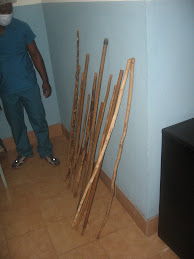 Last weekend, Eric and I and two other westerners were honored to be the only non-family members to be invited to the traditional wedding ceremony for a nurse who works at the eye clinic. This was a great cultural experience and a pleasure to be part of this time in this couple’s lives.
Last weekend, Eric and I and two other westerners were honored to be the only non-family members to be invited to the traditional wedding ceremony for a nurse who works at the eye clinic. This was a great cultural experience and a pleasure to be part of this time in this couple’s lives. 
We were in a nearby village inside a small, dimly lit room with plastic chairs arm-to-arm all around the outside of the room, with the clean dirt floor left clear in the center of the ring of chairs. People’s heads could be seen peeking in from the few windows, backlit by the sun. The ceremony traditionally takes place at the bride’s family’s house and primarily involves the giving of the dowry. No one was smiling. Normally the father of the groom and the uncle of the bride do the bartering as the groom’s family offers the dowry (the “bride price”) to the bride’s family.

The dowry included items such as lengths of cloth, machetes, liquor, live animals (goats), pipes, pots, lanterns, and cash. Items were often brought in pairs and had deeper symbolic significance – for example, lanterns light the way for the couple’s new life together, and machetes mean work and provision. These items were brought one by one and laid on a rug on the floor in the middle of the room.
The ceremony took place in Nzebi, a local language here, so we didn’t understand most of the exchange, but there were some intense emotions as items were offered by the groom’s family and rejected by the bride’s family as being insufficient. They played bartering word-games with one another that were more than half serious, we think. In the end, af
 ter the piles of goods grew considerably in the middle of the floor, the price was accepted and the two patriarchs embraced with joy. Later I asked the groom if it had been more costly than he expected. “Oh, it was a little more than we had thought,” he said, with a small smile – but with a twinkle in his eye and a spring in his step.
ter the piles of goods grew considerably in the middle of the floor, the price was accepted and the two patriarchs embraced with joy. Later I asked the groom if it had been more costly than he expected. “Oh, it was a little more than we had thought,” he said, with a small smile – but with a twinkle in his eye and a spring in his step. 
At the small gathering after the wedding, a truckbed full of gifts of thanksgiving (plantains with live chickens attached) was also presented from the bride’s family to the groom’s family. As the dowry will be distributed among the bride’s family, so this gift will be distributed among the groom’s family.
Marriage here is often a long process. At the beginning is the “presentation,” where the man officially declares his wish to marry the woman. This also involves the giving of gifts to the woman’s family. After this, the couple is considered to be engaged. Then there is the traditional ceremony, as described above. However, in the eyes of the state, the traditional marriage has no legal significance. So there is also a civil ceremony which can be several hours long. Finally, couples who are Christians often want to have a ceremony at the church – this can be as short as a blessing during a regular Sunday service, but often they want a white wedding dress, wedding cake, and a dinner for the guests afterward. All of this is expensive, and sometimes these 4 parts of the marriage process take years or even decades to complete, as the couple saves and saves money.

On an unrelated note, here are some of the promised pictures of our new ophthalmology resident, Dr. Elisee. A couple of days before we left for our conference in Kenya, Dr. Elisee arrived and we welcomed him at the hospital with a “white coat ceremony.” At
 our hospital, this is where the doctor is given the rights and responsibilities inherent to practicing as a Christian physician at our hospital. The hospital administrator, chief surgeon, chief of staff, and myself welcomed hi
our hospital, this is where the doctor is given the rights and responsibilities inherent to practicing as a Christian physician at our hospital. The hospital administrator, chief surgeon, chief of staff, and myself welcomed hi m and he officially began his residency on October 8th, 2009.
m and he officially began his residency on October 8th, 2009. The last photo is a picutre of the eye clinic staff with their new addition.




1 comment:
It often takes years to pay for a marriage in the states... however, we don't wait to have the money... CREDIT!!!
Thanks for the great update, Eric and Wendy!
Post a Comment